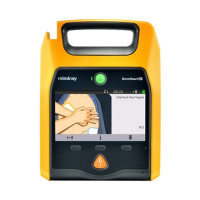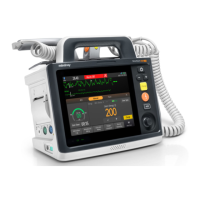C - 3
Note 1: At 80 MHz and 800 MHz, the higher frequency range applies.
Note 2: These guidelines may not apply in all situations. Electromagnetic propagation is affected by
absorption and reflection from structures, objects and people.
a
The ISM (industrial, scientific, and medical) bands between 150 kHz and 80 MHz are 6.765 MHz to 6.795
MHz; 13.553 MHz to 13.567 MHz; 26.957 MHz to 27.283 MHz; and 40.66 MHz to 40.70 MHz. The amateur radio
bands between 0,15 MHz and 80 MHz are 1,8 MHz to 2,0 MHz, 3,5 MHz to 4,0 MHz, 5,3 MHz to 5,4 MHz, 7 MHz
to 7,3 MHz, 10,1 MHz to 10,15 MHz, 14 MHz to 14,2 MHz, 18,07 MHz to 18,17 MHz, 21,0 MHz to 21,4 MHz,
24,89 MHz to 24,99 MHz, 28,0 MHz to 29,7 MHz and 50,0 MHz to 54,0 MHz.
b
Compliance level in the ISM frequency bands between 150 kHz to 80 MHz and in the frequency range 80
MHz to 2.7 GHz are intended to decrease the likelihood that portable/ mobile communication equipment
could cause interference if it is inadvertently brought into patient areas. For this reason, an additional factor
of 10/3 is used in calculating the recommended separation distance for transmitters in these frequency
ranges.
c
Field strengths from fixed transmitters, such as base stations for radio (cellular/cordless) telephones and
land mobile radios, amateur radio, AM and FM radio broadcast and TV broadcast cannot be predicted
theoretically with accuracy. To assess the electromagnetic environment due to fixed RF transmitters, an
electromagnetic site survey should be considered. If the measured field strength in the location in which the
device is used exceeds the applicable RF compliance level above, the device should be observed to verify
normal operation. If abnormal performance is observed, additional measures may be necessary, such as
reorienting or relocating the device.
d
Over the frequency ranges 150 kHz to 80 MHz, field strengths should be less than 3V/m.
Recommended Separation Distances between Portable and Mobile RF, Communications Equipment
and This Equipment
The equipment is intended for use in an electromagnetic environment in which radiated RF disturbance are
controlled. The customer or the user of the equipment can help prevent electromagnetic interference by
maintaining a minimum distance between portable and mobile RF communications equipment
(transmitters) and the equipment as recommended below, according to the maximum output power of the
communication equipment.
Rated Maximum Output
power of Transmitter
Watts (W)
Separation Distance According to Frequency of Transmitter (m)
150 kHz to 80 MHz 80 MHz to 800 MHz 800 MHz to 2.7 GHz
0.01 0.12 0.12 0.23
0.1 0.38 0.38 0.73
1 1.20 1.20 2.30
10 3.80 3.80 7.30
100 12.00 12.00 23.00
For transmitters at a maximum output power not listed above, the recommended separation distanced in
meters (m) can be determined using the equation applicable to the frequency of the transmitter, where P is
the maximum output power rating of the transmitter in watts (W) according to the transmitter manufacturer.
Note 1: At 80 MHz and 800 MHz, the higher frequency range applies.
Note 2: These guidelines may not apply in all situations. Electromagnetic propagation is affected by
absorption and reflection from structures, objects and people.

